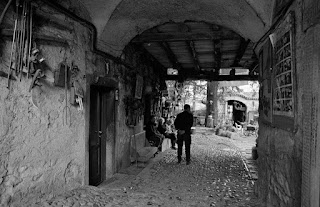I noticed that both films had the first pictures with light leaks - since I hope that both cameras did not suddenly develop sealing issues, I suppose that the canisters are not extremely light tight (I suppose the velvet baffles). I did load the camera in subdued light and the leaks do not look like light-piping: also RPX400 (as well as RPX100) are coated on traditional substrate and not PET/ESTAR like some other Rollei films.
The resulting negatives look a bit thin, 15"-30" more would be advisable, I will test next time. However the dynamic range is impressive as is the compensating effect of film+developer, as can be seen in some examples below, where the dynamic range was very high and the highlights retained full detail.
I used this film during documentation of FAI Giornate di Primavera, which mean a mix of inside/outside lightning: documenting places and people during this unique event.
Here some images with Nikon F501
Here some images with Olympus OM-1
Rural conditions and traditional works:
 |
| Olympus OM-1 - Zuiko 50mm/1.4 - RPX400 |
 |
| Olympus OM-1 - Zuiko 50mm/1.4 - RPX400 |
 |
| Olympus OM-1 - Zuiko 28mm - RPX400 |
Inside the Palazzo Podestà of Vilminore with halogen light the compensating effect of this developer is so strong that the result reminds me of stand development!
 |
| Olympus OM-1 - Zuiko 24mm - RPX400 |
Here similar condition inside the Palazzo Moroni in Bergamo, where ambient light is prevalent, but detail is retained in the highlights and texture in the windows outside!
 |
| Nikon F501 - Nikkor 28/3.5PC - RPX400 |
 |
| Nikon F501 - Nikkor 28/3.5PC - RPX400 |
 |
| Nikon F501 - Nikkor AF 28/2.8 - RPX400 |
Nessun commento:
Posta un commento